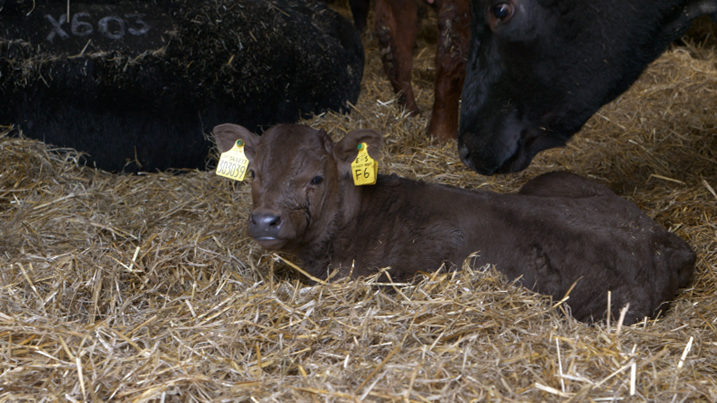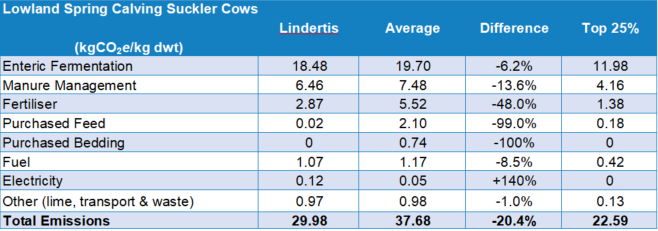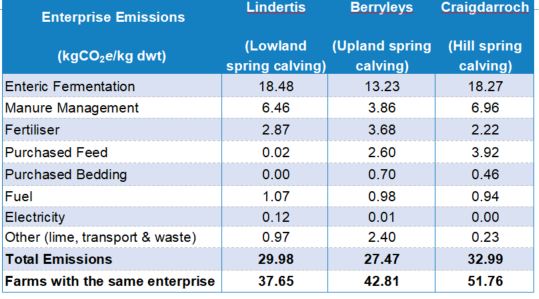Calving Heifers at 2 Case Study
3 April 2023Tom Hopkinson, Lindertis Farms
Lindertis Farm is a 800 ha mixed livestock and arable farming business based just outside of Kirriemuir, Angus. The farm runs 160 breeding cows. with 60 of them being pedigree Aberdeen Angus. The commercial cows are Aberdeen Angus cross Simmental.
With the exception of the heifers retained for breeding all progeny is finished on farm.
The farm also grows malting barley, feed barley, winter wheat, oilseed rape, oats, raspberries and beans.

Heifer Selection and Management
Lindertis have been calving their heifers at 2 years of age for over 15 years. They are keen to improve the genetics of their herd and so retain around 40 heifers each year that are bulled at 13-14 months of age. The heifers kept for breeding are all selected from calves born in the first cycle and consideration is given to longevity in the family line, temperament, feet and milkiness in the dam.
The heifer calves averaged 360 kg at weaning and move onto a tailor-made TMR forage-based ration for their first winter to ensure that they are 65% of mature weight at bulling. The bulls that are to be used in the coming breeding season are fertility tested in March to allow any problems found to be dealt with prior to the bulls working. Bulls are selected on figures, in particular moderate calving ease, with attention paid to birth weight EBV. Ideally Tom is looking for bulls with a light birth weight but a fast growth rate.
The bulls are out with the heifers and cows from 27th May until 29th July, giving a nine week bulling period and they were scanned five weeks later at the start of September to allow the pregnancy to be aged and cows batched according to date of service.
A conception rate of 93% was achieved in the 41 heifers put to the bull, which Tom admits is lower than his target of 95%. Three heifers were empty and removed from the group on the day of scanning to enter the finishing pen with the aim of slaughter by 24 months of age. Two of these were the youngest in the group, and this may have been a factor in their inability to hold.
Tom is now questioning if he should reduce the bulling period to six weeks instead of nine after 76% heifers were served in the first cycle, 18% in the second cycle and only two heifers (5%) in the third cycle.
At scanning the heifers are wormed and blood tested for Johne’s with no positive results this year. The heifers are turned back out to grass with access to ammonia treated straw in ring feeders. The heifers were housed mid November when they were given a fluke treatment and IBR booster. The ration fed from mid November to calving in March is 4 kg ammonia treated straw and 15 kg silage, with the aim being to keep the condition steady throughout the winter. Pre-calving the heifers receive booster vaccines for BVD, leptospirosis, mycoplasma and neonatal scour (rotavirus, coronavirus and E.coli).
Calving Management
Calving was due to start on 5th March, however the first calf was born on 26th February and 30 heifers and cows had calved by 5th March. So far calving has gone well with no heifers requiring assistance at calving. One of the early calved heifers required help to get calf suckling, but otherwise all heifers have shown great mothering ability. Despite heifers being in very good condition at housing, this does not seem to have affected their ease of calving and Tom is happy with their milkiness and calf vigour.

Calves have their navels treated as soon after birth as possible and are tagged and rubber ringed (if commercial males) within 24 hours of birth. The heifers and their calves are run as a single group in one shed.
Following calving the heifers are run as one group and are fed a small amount of supplementary feeding on top of the silage ration while housed. Once weather and grass availability is suitable the heifers are turned out into grass rotations in their heifer group to ensure plenty of grass in front of them to allow them to grow on, grow a calf, and get back in calf once the bull is introduced in May.
Impact of Calving at 2 on the Farm's Carbon Footprint

The carbon footprint for the beef enterprise at Lindertis for the year ending September 2022 was 29.98 kg CO2e/kg dwt, which was 20.4% lower than average spring calving lowland herds and 32.7% higher than the top 25% of producers.
The Lindertis herd predominantly uses Aberdeen Angus genetics to produce a moderately sized cow and through good grassland management and winter forage crops, the grazing season has been extended, such that cows are only housed for calving between February and April.
All of the feed and bedding required is supplied by the farm’s arable enterprises, with only minerals being purchased, so emissions associated with purchased feed and bedding are 99% and 100% less than the average.
Comparing the Focus Farmers' Calving at 2, 2.5 and 3
To compare the impact of calving heifers at 2, 2.5 and 3 years old, Lindertis, Berryleys and Craigdarroch each completed a carbon audit for the year ending September 2022 using SAC's farm calculator tool, Agrecalc. The enterprise emission and technical performance comparison data is shown in the tables below.


All three farms have carbon footprints for their beef enterprises well below the comparative average for the systems they run. This is largely due to their excellent fertility and low mortality. The variation between the level of output from the three farms reflects the different systems they run, with Craigdarroch operating an extensive, low-input herd, whereas Berryleys operates an intensive bull-beef finishing and forage-based suckler herd, with Lindertis sitting between these.
This is also mirrored in the daily live weight gains of the three farms. Mature cow size influences feed use too, with the large Simmentals at Berryleys requiring more feeding than the smaller Luings at Craigdarroch. Overall there is little difference in the carbon footprint of farms calving heifers at 2, 2.5, or 3 years old, as all three farms studied utilise their resources efficiently.
In summary, choosing the right age at first calving is highly dependant on the system operated and ultimately good management (nutrition, heifer selection, BCS and genetics) is key to ensuring heifers reach growth targets and successfully rebreed. For more information on this ‘Choosing the right age to calve heifers’ series visit the FAS webpage —www.fas.scot/livestock/calving-heifers-vlog-series.
Author—Lesley Wylie, SAC Consulting
March 2023
Sign up to the FAS newsletter
Receive updates on news, events and publications from Scotland’s Farm Advisory Service
